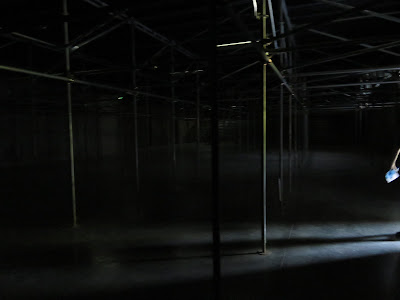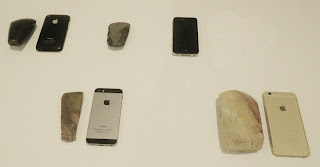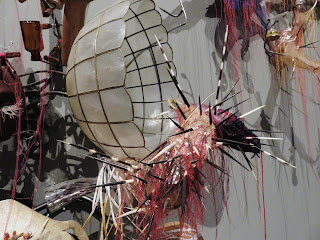 |
| Polys Peslikas |
At the Arsenal, I was at first put off by the New Zealand offering of a very long panoramic animated history that started with images that reminded me of the movie “Moana,” which I had just watched on the airplane. Then as the Europeans arrived, it seemed likely to erupt in conflict, but it didn’t and we left well before the end, again our impatience with time-based art manifesting itself. In retrospect, it seemed a contemporary version of the historical painted panoramas that were popular in the 19th century in Europe and the United States, the history gradually emerging on a very long screen.
The Italian pavilion was completely different from its
previous two iterations, focusing on only three artists rather than the dozens
we’d seen there before, and titled Il Mondo Magico, (The Magic World). One installation created a sort of tunnel of translucent material,
with side passages that led to little rooms with cadaver-like sculptures on
tables. At the end of the tunnel was a workshop, where the figures were
supposedly made, and a wall with many figures hanging against it. It felt
rather creepy, something about death, degeneration, maybe crucifixion, since
some of the forms were posed as if taken from a cross. The artist’s statement,
by Roberto Cuoghi (b. Modena 1973) calls it a factory for turning out
devotional figures.
 |
| Roberto Cuoghi |
Another space was a large substructure, which I didn’t
understand; it looked like some kind of warehouse, bare metal columns and wood.
At the end was a bleacher-like set of stairs we were encouraged to climb. It
was quite dark. From the top one looked back and saw that the substructure
supports a reflecting pool that provides a mirror image of the vaulted roof of
the building. The effect is something like an infinity pool and a bit
disconcerting and pretty cool, but reminded me of other similar water illusions
I’ve seen. My main memory is of my own unsteadiness going down the stairs,
which must be traversed at an angle, and of some concern that the heavy water
would break the substructure. The label explains that the artist, Giorgio
Andreotta Calo, intended the substructure to be read as a church and the upper
area to refer to something called the mundus
Cereris, a mythical pit near Rome that served as a door between the
underworld and heaven. The work is titled Sensa
titolo (La fine del mondo)
 |
| Giorgio Andreotta Calo, Sensa titolo (La fine del mondo) |
Years ago, when the Chinese first had a pavilion in the
Arsenale, it was in a space filled with huge drums, a dark place with
relatively narrow passageways between the drums. Creating art for that space
was an interesting challenge. Now all but one of the drums (symbolic of the
past, I assume) are gone and the pavilion is light and spacious with white
walls. And the art seems more ordinary as a result. Several artists were
included and it was not very easy to distinguish who had done which objects.
The guide indicates that the pavilion combines folk crafts with contemporary
artists. There was an investigation by Wang Tianwen of the concept of shadow
puppets, including very intricately cut sculptural forms suspended from the
ceiling - one of these was also on view outside the gallery - plus shadow
puppet contraptions. Large videos, I think by Tang Nannan, of things happening
in the sea caught my attention. I never really figured out what they were about
but found the scale of the images memorable.
 |
| Wang Tianwen |
 |
| Tang Nannan video, showing scale |
We used to hunt for the Mexico pavilion when it was located
in a palace or church somewhere in Venice. For the past couple of Biennales,
Mexico has had a relatively small space in the Arsenale and its offerings have
been less intriguing to us. Perhaps the act of hunting for the pavilion
increased its previous interest. In this case Carlos Amorales had created his own
alphabet in order to tell a story of the lynching of an immigrant in Mexico. At
least that’s what the label says. I was unable to make anything of the letters,
so the label seemed to define the conceptual artwork.
Speaking of immigration, a video of Alec Baldwin and
Julianne Moore caught my attention for a surprisingly long time. Eventually I
ascertained that they were speaking the first-person experiences of various
migrants crossing the Mediterranean, and I was surprised that my response to
their reports of the experiences were more moving to me than the reports given
by the actual immigrants, which appeared on videos in the next room. It’s
mortifying but informative to realize how one responds to “the other,” as
opposed to one’s “own kind.” Titled “Love
Story,” by Candice Breitz, (b. Johannesburg, 1972), it was an extremely effective
work of political art, at the South Africa Pavilion, in the Arsenale.
 |
| Julianne Moore in "Love Story" by Candice Breitz |
Not far from
Piazza San Marco were a small group of particularly effective spaces, in
various parts of a small palazzo. In the palazzo courtyard, the path to the
Mongolian Pavilion was lined with birds, cranes, actually, bronze sculptures cast
as if from rifles by Chimeddorj Shagdarjav (b. 1954). The flock, I Am a Bird, increases inside the pavilion, for a total of 60. Cranes represent happiness and eternal youth
in Asia, and the concept of the beautiful and graceful birds suggests an
alternative to guns. Another Mongolian sculptural project, Karma of Eating, by Munkkh Munkhbolor-Ganbold (b. 1983) is a kind of shamanistic gathering of the
skulls of a few of the millions of animals that died in exceptionally cold
winters and droughts in 2010, a disaster exacerbated by the overbreeding of goats
for the cashmere business. The other three projects also address environmental
degradation and exploitation.
 |
| Chimeddorj Shagdarjav, I Am a Bird |
 |
| Munkkh Munkhbolor-Ganbold, Karma of Eating |
Nearby, the Mauritius pavilion proclaimed a dialogue among international artists, including work by Robert Rauschenberg, on the principle that it recreated the Edenic unity of the prehistoric Gondwanaland, one of the prehistoric supercontinents, which contained most of the southern hemisphere land mass. Traces of the continent were recently found under Mauritius. The Rauschenbergs were wonderful, better than much of the recent Rauschenberg retrospective at the Tate and MOMA. Of the other artists, I was most struck by the day-glo abstract utopian visions of SEO (b. Gwangju, Korea, 1977).
One of my very favorite pavilions was that of Andorra. Titled
Murmuri, and by the ceramicist Eve
Ariza, the room had black walls covered with hundreds of ceramic vessels
ranging in color from black through brown and cream. The attendant explained
that the vessels were the colors of human skin and that each of the vessels
makes a sound if you listen quietly, i.e. they murmur, as the title suggests.
Looking more closely, the bowls are crimped at the bottom, making a form that
suggests lips. If I had one pavilion to recommend in Venice, this would be it.






















































